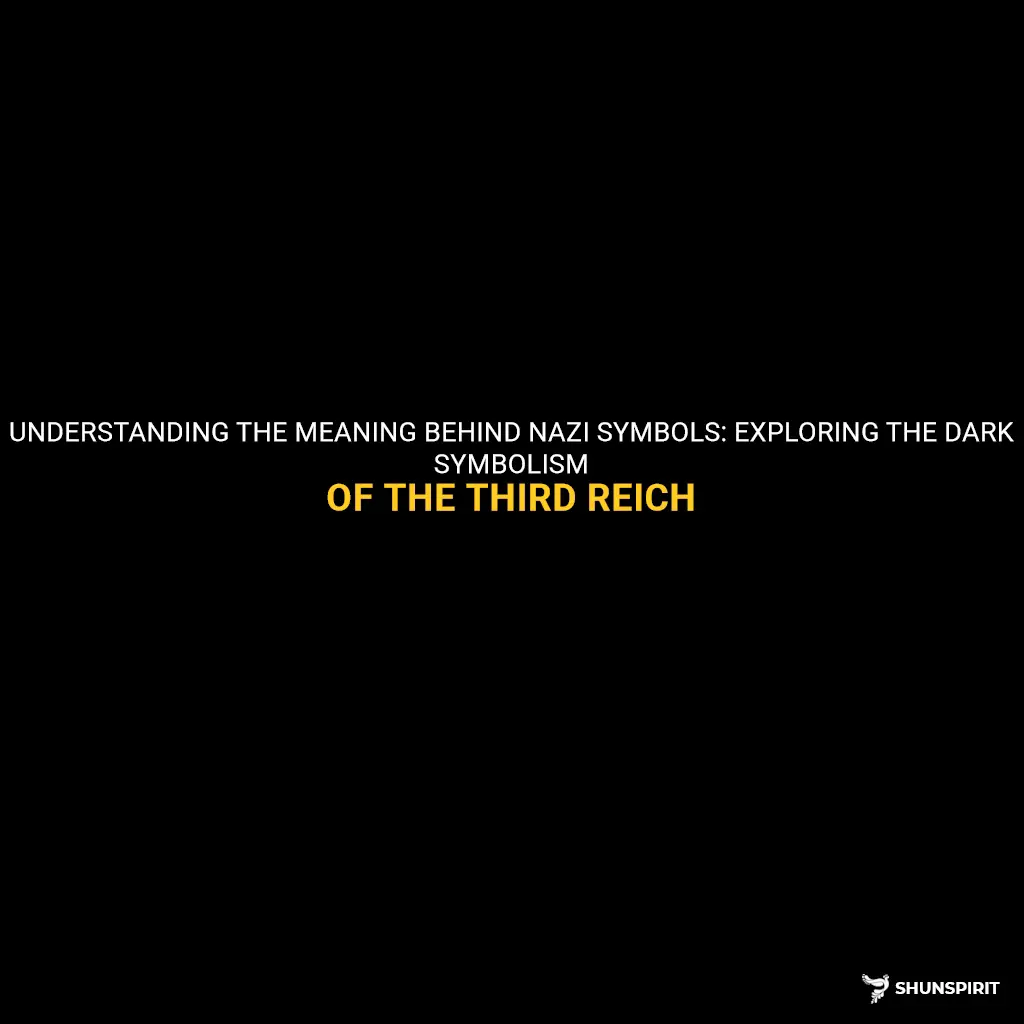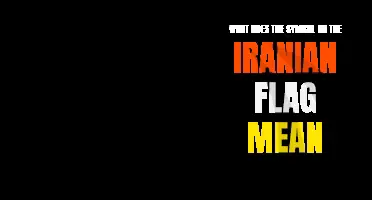
The Nazi symbol, known as the swastika, remains one of the most recognizable and controversial symbols in history. For many, it represents the horrors and atrocities committed during the reign of Adolf Hitler and the Third Reich. However, the swastika's origins predate Nazi Germany, and its meaning varies across different cultures and time periods. In this article, we will explore the complex and often conflicting symbolism behind the Nazi symbol, shedding light on its historical significance and the profound impact it continues to have to this day.
What You'll Learn
- What is the meaning behind the Nazi symbol, the swastika?
- How and why did the Nazi party appropriate the swastika as their symbol?
- Are there any alternative meanings or interpretations of the Nazi symbol?
- How has the understanding and perception of the Nazi symbol evolved over time?
- What steps have been taken to combat the use and display of the Nazi symbol in modern society?

What is the meaning behind the Nazi symbol, the swastika?
The swastika, a symbol that was once a revered religious emblem in ancient cultures, now carries with it a heavy burden. Most notably associated with the Nazis and their horrific actions during World War II, the swastika has become a symbol of hate, racism, and genocide. But what was the original meaning behind the swastika, and how did it come to be associated with the Nazis?
The swastika is an ancient symbol that has been used in various cultures and religions for thousands of years. Derived from the Sanskrit word "svastika," which means "well-being," the swastika was originally a symbol of good luck, fortune, and prosperity. It can be found in numerous civilizations including ancient Greece, India, China, Japan, and Native American tribes.
In Hinduism, the swastika is considered a sacred symbol representing the sun and the cycle of life. It is often used in religious ceremonies and rituals and is considered to bring good luck, happiness, and health. Similarly, in Buddhism, the swastika is seen as a symbol of eternity, auspiciousness, and the Buddha's footprints.
So how did the swastika become associated with Adolf Hitler and the Nazi regime? In the early 20th century, the swastika was adopted by various nationalist and racist groups in Europe. The Nazi Party, led by Hitler, saw the swastika as a symbol of their own movement and ideals. They believed that by using the swastika, they could make a connection to ancient Aryan civilizations and promote their own vision of racial superiority.
The Nazis used the swastika extensively, incorporating it into their party logo, flags, uniforms, and propaganda. Hitler himself claimed that the swastika represented the "Aryan race," which he believed to be superior to all other races. It became a symbol of the Nazi ideology, which advocated for the elimination of perceived "inferior" races and the establishment of a totalitarian regime.
The association between the swastika and the Nazis has had a lasting impact on its meaning. Today, the swastika is universally recognized as a symbol of hate, racism, and genocide. Its use is banned in many countries, including Germany, where it is considered a criminal offense to display or promote the swastika.
In an effort to reclaim the swastika's original meaning, some groups and individuals have tried to differentiate between the ancient symbol and its Nazi connotation. They argue that the swastika should be understood and respected in its original context, divorced from the atrocities committed by Hitler's regime. However, despite these efforts, the swastika remains a potent symbol of hate and serves as a reminder of the darkest chapter in human history.
Ultimately, understanding the meaning behind the swastika requires acknowledging its ancient origins while also recognizing its association with hate and genocide. It is a stark reminder of the power symbols can hold and the importance of promoting tolerance, inclusivity, and respect in society.
Cracking the Code: The Meaning Behind Air Conditioner Symbols
You may want to see also

How and why did the Nazi party appropriate the swastika as their symbol?
The swastika is a symbol that has been used by various cultures for thousands of years. The symbol itself is a geometric figure made up of intersecting lines that form a cross with bent arms. It has been used in different contexts, representing different things depending on the cultural and historical context. However, in contemporary society, the swastika is most commonly associated with the Nazi party and their atrocities committed during World War II.
The appropriation of the swastika by the Nazi party was a deliberate and strategic decision made by Adolf Hitler and the party leadership. They chose the swastika primarily because they believed it had strong symbolic and historical significance. The swastika had been used by various ancient cultures, including the ancient Aryan civilization, which the Nazi party claimed as their ancestral heritage. Hitler believed that by coopting the swastika, the Nazi party could tap into the power and authority associated with these ancient civilizations.
Additionally, the swastika was seen as a symbol of racial purity and superiority, which was a central tenet of Nazi ideology. Hitler and his followers believed in the superiority of the Aryan race and sought to create a racially pure society. By adopting the swastika, they were able to visually represent this ideology and align themselves with the concept of racial purity. The swastika, with its clean lines and geometric precision, epitomized the ideals of order and purity that the Nazi party aspired to.
Furthermore, the swastika was chosen for its shock value and ability to evoke strong emotions in people. It was a symbol that many people were familiar with, and its use by the Nazi party was a deliberate attempt to provoke and intimidate their enemies. The Nazis understood the power of visual symbolism and used the swastika as a tool to rally their supporters and strike fear into their opponents.
The swastika’s appropriation by the Nazi party has had a lasting impact, forever associating the symbol with hate, racism, and genocide. In the aftermath of World War II, the swastika was banned in many countries and its use became a criminal offense. It is now universally recognized as a symbol of hate and is condemned by the majority of people. The Nazi party's appropriation of the swastika not only tarnished its historical significance but also forever stained its legacy.
In conclusion, the Nazi party appropriated the swastika as their symbol for several reasons. They believed it had strong symbolic and historical significance, representing the power and authority of ancient civilizations. It also visually represented their ideology of racial purity and superiority. Additionally, the swastika was chosen for its shock value and ability to provoke strong emotions. The swastika’s appropriation by the Nazi party has had a lasting impact, forever associating the symbol with hate and their atrocities committed during World War II.
The Symbolic Meaning and Cultural Significance of the Praying Mantis
You may want to see also

Are there any alternative meanings or interpretations of the Nazi symbol?
The Nazi symbol, also known as the swastika, is widely recognized as the primary emblem of the Nazi Party and is associated with the atrocities committed by Adolf Hitler's regime during World War II. However, it is important to note that the swastika has a history that predates the Nazi regime and holds alternative meanings in different cultures.
The swastika is an ancient symbol that has been used for thousands of years in various cultures around the world. In Hinduism, Buddhism, and Jainism, the swastika is considered a sacred symbol representing auspiciousness, good luck, and prosperity. In these contexts, it is often depicted with a different orientation and is known as the "right-facing swastika." It is used to convey positive values and is a revered symbol in these religions.
In pre-Nazi Europe, the swastika was also used as a symbol of luck and good fortune. It could be found on artifacts, textiles, and architecture, and was not associated with any negative connotations. Its use in these contexts can be traced back to ancient Greece, where it was known as the gammadion cross. The gammadion cross was used as a decorative element and believed to bring good luck.
However, with the rise of Adolf Hitler and the Nazis in Germany during the 1930s, the swastika became a symbol of hate, discrimination, and genocide. Hitler adopted the swastika as the emblem of the Nazi Party, turning it into a symbol of the oppressive and violent ideology of the Nazi regime. The atrocities committed under the swastika during the Holocaust and World War II have forever stained its reputation and made it a universally recognized symbol of hate.
In light of its association with the Nazi regime, the public display of the swastika is heavily regulated in many countries, including Germany, where it is illegal to publicly display Nazi symbols. The ban on the swastika is aimed at preventing the glorification of Nazi crimes and ensuring that the symbol does not incite hatred or promote discrimination.
Despite the negative connotations associated with the Nazi swastika, there are instances where it continues to be used or appropriated for different purposes. In some contexts, it may be used as a form of shock value or as a symbol of rebellion against societal norms. However, these uses are often seen as controversial and can be highly offensive to those who were victimized by the Nazi regime.
It is crucial to understand the historical context and significance of symbols like the swastika. While it may have held positive meanings in the past, its association with the Nazi regime and the atrocities committed under its banner have forever changed its interpretation for many around the world. The swastika serves as a reminder of the dangers of hatred, discrimination, and the consequences of unchecked power. It is incumbent upon society to educate and raise awareness about the true history and meaning of symbols like the swastika to prevent their misuse and ensure a more inclusive and tolerant future.
Unlocking the Hidden Meanings Behind Alchemical Symbols
You may want to see also

How has the understanding and perception of the Nazi symbol evolved over time?
The Nazi symbol, most commonly known as the swastika, has a long and complex history. It was originally a symbol of good luck and auspiciousness in many ancient cultures, including Hinduism and Buddhism. However, its association with the Nazi party and Adolf Hitler during World War II dramatically changed its meaning and perception.
The swastika was adopted by the Nazi party in the early 1920s as their emblem. Hitler and his followers aimed to create a strong and unified German state, and they believed that the symbol could be used to represent their ideals of Aryan supremacy and nationalism. The swastika became a powerful visual representation of the Nazi regime, symbolizing hate, racism, and genocide.
During World War II, the swastika was seen as a symbol of fear and oppression in places under Nazi control. It was prominently displayed on flags, uniforms, and propaganda posters, instilling a sense of dominance and superiority in the minds of the German people. The perception of the swastika during this time was undoubtedly negative, as it was associated with one of the darkest periods in human history.
After the defeat of the Nazi regime in 1945, the swastika became widely recognized as a symbol of hatred and bigotry. It was stigmatized and banned in many countries, including Germany, where the public display of Nazi symbols is illegal. The understanding of the swastika shifted from a symbol of good luck to a symbol of evil, reminding the world of the atrocities committed by the Nazis during the Holocaust.
Despite its negative connotations, the swastika still holds cultural and religious significance for many non-Nazi groups. In countries like India, the swastika continues to be used as a religious symbol to represent auspiciousness, prosperity, and well-being. It is important to separate the swastika as a symbol of the Nazis from its original cultural context, where it held positive meanings.
In recent years, there has been debate and controversy surrounding the use of the swastika in non-Nazi contexts. Some argue that the symbol should be reclaimed and recontextualized to its original meanings, separate from its association with the Nazi party. Others believe that the swastika should be permanently stigmatized and banned, given the immense pain and suffering it represents.
Overall, the understanding and perception of the Nazi symbol, particularly the swastika, has evolved significantly over time. From a symbol of good luck and auspiciousness, it has become a symbol of hate and racism. The Nazi party's association with the swastika during World War II permanently changed its meaning and reputation. Although it still holds cultural and religious significance in some contexts, the swastika remains primarily associated with the horrors of the Nazi regime.
Deciphering the Symbols on Your Danby Dehumidifier: What Do They Mean?
You may want to see also

What steps have been taken to combat the use and display of the Nazi symbol in modern society?
In modern society, the use and display of the Nazi symbol, also known as the swastika, is widely regarded as a symbol of hate and represents the atrocities committed during the Holocaust. Recognizing the need to combat the resurgence of neo-Nazism and prevent the spread of hate speech, governments, organizations, and individuals have taken various steps to address this issue. This article aims to explore the actions and initiatives that have been implemented to combat the use and display of the Nazi symbol in modern society.
Legal Measures:
One of the most significant steps taken to combat the use of the Nazi symbol is through legal measures. Many countries, including Germany, France, the United Kingdom, and Poland, have enacted laws that prohibit the public display or use of Nazi symbols and ideologies. These laws aim to prevent the promotion and glorification of Nazi ideals while ensuring that historical references are not misunderstood as endorsing the symbols.
Education and awareness programs:
Education and awareness programs play a vital role in combatting the use of the Nazi symbol. Schools and educational institutions have integrated Holocaust education into their curriculum, teaching students about the historical context of the Nazi regime and the atrocities committed during World War II. These programs aim to promote tolerance, understanding, and critical thinking, enabling students to identify and reject hate symbols and ideologies.
Museums and memorials:
Museums and memorials dedicated to the Holocaust have emerged as significant tools in combatting the use of the Nazi symbol. Institutions such as the United States Holocaust Memorial Museum in Washington, D.C., and the Auschwitz-Birkenau State Museum in Poland provide powerful depictions of the Holocaust, educating visitors about the consequences of hate speech and the dangers of extremist ideologies.
Social media policies:
With the rise of social media, it has become necessary to combat the spread of hate symbols online. Many social media platforms have implemented strict policies that prohibit the use or display of Nazi symbols. These platforms actively monitor and remove content that promotes hate speech, working alongside organizations that specialize in identifying and reporting instances of hate symbolism.
Community outreach and engagement:
To combat the use of the Nazi symbol, community outreach and engagement initiatives have been crucial. Grassroots organizations, religious institutions, and community centers organize events, workshops, and discussions to spread awareness about the dangers of hate speech, emphasizing the importance of embracing diversity and promoting inclusivity.
International cooperation:
The fight against the use and display of the Nazi symbol requires global cooperation. International organizations, such as the United Nations, work to combat hate speech through campaigns, resolutions, and collaborations with member countries. These efforts aim to create a united front in denouncing hate symbols and ideologies across the globe.
While significant progress has been made in combating the use and display of the Nazi symbol, it remains an ongoing battle. Continued focus on education, awareness, and robust legal measures is essential to prevent the normalization and proliferation of hate speech and extremist ideologies. By standing together against hate symbols, societies can strive towards a more tolerant and inclusive future.
The Meaning and Significance of the Atom Symbol
You may want to see also
Frequently asked questions
The Nazi symbol, also known as the swastika, was originally an ancient religious symbol found in various cultures around the world. However, during Adolf Hitler's time, the swastika was adopted as the emblem of the Nazi Party and became associated with their ideals of racial superiority and hatred towards those they deemed inferior. Therefore, the Nazi symbol represents the darkest parts of human history, including genocide and fascism.
The Nazi symbol is banned in many countries because of its association with the atrocities committed by the Nazi regime during World War II. The swastika has become a symbol of hate, racism, and antisemitism. Its presence can be deeply offensive and traumatic to those who were victims of the Holocaust or who continue to face discrimination and persecution today. Banning the Nazi symbol is a way to condemn and prevent the spread of these ideologies, promoting tolerance and respect for all people.
While the Nazi symbol has a long history before its association with the Nazi Party, its use is heavily stigmatized due to its association with hate and violence. In many countries, the use of the Nazi symbol is strictly regulated, and its use for any purpose other than historical or educational purposes is generally forbidden. In some cases, exceptions may be made for academic research or artistic expression with the intention of promoting understanding, but even then, it is a highly sensitive and controversial topic.







